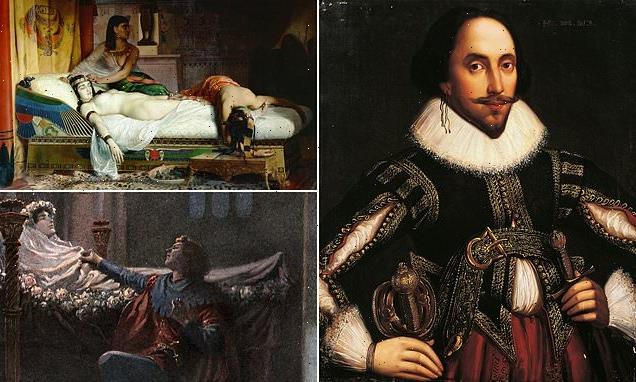
The cold Bard truth: Scientist brands Shakespeare’s death scenes ‘unrealistic’ as poison killed Cleopatra ‘too quickly’ and Juliet would have had ‘some side effects’ after 42 hours without breathing
- A British chemist has deemed Shakespeare’s iconic death scenes as ‘unrealistic’
- She claims heroine Cleopatra died too quickly after being bitten by a snake
- Juliet would have ‘some side effects’ had she spent 42 hours without breathing
- However, she admits that poison from a puffer fish could achieve this effect
He killed more than 70 of his characters on stage, including stabbings, snakebites and beheadings, but even Shakespeare got it wrong sometimes.
Scientific analysis of the Complete Works of Shakespeare has revealed that Cleopatra died unrealistically quickly after choosing death by snake.
The murder of Hamlet’s father made little sense, as pouring poison in someone’s ear accesses few blood vessels to get it into their system.
And Juliet could not have taken anything which would make her appear dead for a full 42 hours, although a toxin from a puffer fish could have had a similar effect.
Dr Kathryn Harkup, the scientist who closely examined the deaths of Shakespeare, told Cheltenham Science Festival: ‘He’s good at observation, but without necessarily understanding the science of what’s going on.’
Dr Harkup described scientific issues with a number of deaths in Shakespeare’s plays
Juliet fakes her own death with a potion which leads her apparently dead for ‘two and forty hours’. A chemical called tetrodoxin, found in pufferfish, could make someone appear as if they have stopped breathing and slow their pulse (stock image)
WHAT SHAKESPEARE GOT WRONG
During Shakespeare’s time, when the average life expectancy in England was the age of 35, hangings were held in public for most crimes, and traitors’ decapitated heads were displayed on spikes south of the River Thames, people were very interested in death, according to Dr Harkup.
It meant Shakespeare’s plays had to be gory and grisly to keep audiences entertained, with two men killed, baked in a pie and fed to their mother in Titus Andronicus, the poet Cinna in Julius Caesar murdered by a baying mob, and the character Antigonus killed offstage by a bear in The Winter’s Tale.
Dr Harkup described scientific issues with a number of deaths in the plays however, based on her book Death By Shakespeare.
These include the death of Hamlet’s father, killed by his brother Claudius, who poured poison into his ear.
The name of the poison, ‘hebenon’ or ‘hebona’, is not real, and it would not work well, according to Dr Harkup, because ear wax and cartilage would block the substance from getting into the body.
Cleopatra speaks only a few lines after clasping a snake to her breast, to bite her, and then another to her arm, and then apparently dies relatively peacefully. That is unrealistic, according to Dr Harkup, who said ‘this is not a gentle death – this is painful.’
In the tragedy Antony and Cleopatra, Cleopatra, the queen of Egypt, has lost the love of her life and is about to lose her empire so arranges to have a poisonous snake, or ‘asp’ delivered to her in a basket of figs.
Dr Harkup points out that a lethal Egyptian cobra would need to be up to 1.5 metres, or almost five feet, in length, making it very hard to smuggle in a basket of figs.
Cleopatra speaks only a few lines after clasping a snake to her breast, to bite her, and then another to her arm, and then apparently dies relatively peacefully.
That is unrealistic, according to Dr Harkup, who said of the snake venom: ‘It will hurt like hell en route. This is not a gentle death – this is painful.’
Snake venom will indeed cause death by respiratory collapse, but Dr Harkup said: ‘It takes time to suffocate – she’s got a bit of writhing around on her imperial bed to get through.
‘She’s got more than a few lines, in reality.’
Cleopatra’s choice of where the first snake would bite her, on the breast, is one of the most painful parts of the body, according to a study on bee stings.
In Romeo and Juliet, the female lead fakes her own death, with a potion which leads her apparently dead for ‘two and forty hours’ – almost two days -stopping her pulse and breathing.
A chemical called tetrodoxin, found in pufferfish, could make someone appear as if they have stopped breathing and dramatically slow their pulse.
Shakespeare may have heard of it through traders from Japan, who ate fugu – the pufferfish – and risked paralysis and death if it was not prepared properly to remove the poisonous parts.
But, Dr Harkup, said, the play suggests there would be no medical issues from taking such a toxin, to which she said: ‘If you don’t breathe for 42 hours, I suggest that there might be some side effects.’
WHAT SHAKESPEARE GOT RIGHT
A bear killing someone, as in The Winter’s Tale, would be pretty unlikely in the general way of things, according to the scientist.
But this is something Shakespeare likely got right, as bears brought to London for entertainment were chained up, made to dance, or involved in bear-baiting, where dogs attacked a captive bear.
These bears would have ‘a few scores to settle’, according to Dr Harkup, who said: ‘The idea of a bear getting loose and attacking someone and eating them was probably a very realistic and well-known event.
‘It certainly would have got talked about in Shakespeare’s day.
‘So what seems very odd today was probably the least odd bit about that play.’
Finally, deaths from a broken heart are also plausible, although Dr Harkup says this is Shakespeare ‘stretching things a bit’.
Mamillius, the child in The Winter’s Tale who apparently dies of a broken heart after learning his father has cruelly jailed his mother, may have had a genetic disorder affecting his heart, which a sudden shock made fatal.
Lady Capulet, who died of a broken heart after hearing of her son Romeo’s banishment, may have suffered ‘broken heart syndrome’ which is caused by extreme stressful events and can rapidly weaken the heart muscle.
William Shakespeare: The playwright, poet and actor whose reputation transcends all other writers
William Shakespeare (baptised April 26, 1564 – died April 23, 1616) was an English playwright, poet, and actor who is widely believed to have been the greatest dramatist of all time.
The playwright continues to occupy a position unique in world literature as someone whose reputation transcends that of all other popular writers.
He is credited with producing 39 plays, 154 sonnets and three long poems.
His plays, the most famous of which include Romeo and Juliet, Hamlet and Othello, have been translated into every major language.
They are performed thousands of times a year by actors all across the world and are studied by millions of students across the UK and elsewhere.
William Shakespeare (baptised April 26, 1564 – died April 23, 1616) was an English playwright, poet, and actor who is widely believed to have been the greatest dramatist of all time
Shakespeare was born and raised in Stratford-upon-Avon, Warwickshire.
He married Anne Hathaway at the age of 18 and had three children with her: Susanna and twins Hamnet and Judith.
At some point between 1585 and 1592, Shakespeare began a career in London as an actor and writer.
He was the part owner of a playing company called the Lord Chamberlain’s Men, who later became known as the King’s Men.
They built the Globe Theatre, in Southwark, South London, at which they performed many of Shakespeare’s plays.
The theatre was destroyed by fire in 1613 but rebuilt the following year before being closed in 1642 and then pulled down.
A modern reconstruction of the Globe, named ‘Shakespeare’s Globe’, was built less than 800 feet from the site of the original theatre and opened in 1997.
At the age of 49, Shakespeare is believed to have retired back to Stratford, before he died three years later.
However, there are scant records of his private life and considerable speculation continues about his exact physical appearance.
Some questions have also been raised about whether all the works attributed to him were in fact written by others.
Source: Read Full Article



